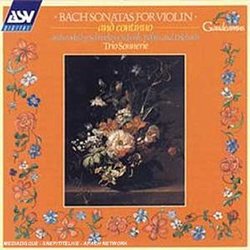| All Artists: Trio Sonnerie Title: Assorted Works Members Wishing: 0 Total Copies: 0 Label: Asv Living Era Release Date: 12/21/1993 Genre: Classical Styles: Chamber Music, Forms & Genres, Suites, Historical Periods, Baroque (c.1600-1750), Instruments, Strings Number of Discs: 1 SwapaCD Credits: 1 UPC: 743625010725 |
Search - Trio Sonnerie :: Assorted Works
 | Trio Sonnerie Assorted Works Genre: Classical
|
Larger Image |
CD Details |
CD ReviewsGerman Baroque Chamber Music - and a Fascination All Its Own Leslie Richford | Selsingen, Lower Saxony | 11/07/2008 (4 out of 5 stars) "Trio Sonnerie [Monica Huggett, violin; Sarah Cunningham, viola da gamba; Mitzi Meyerson, harpsichord] plays German chamber music of the 17th and 18th centuries:
1. Johann Sebastian Bach (1685-1750): Sonata in E minor for Violin and continuo, BWV 1023. 2. Johann Sebastian Bach: Sonata in G major for Violin and continuo, BWV 1021. 3. Johann Heinrich Schmelzer (c. 1623 - 1680): Trio Sonata IX in A minor for violin, viola da gamba and continuo. 4. Johannes Schenk [sometimes also spelt "Schenck"): Suite in A major from "Scherzi musicali" [with Alison Crum, viola da gamba continuo]. 5. Georg Böhm (1661 - 1733): Suite VII in F major for harpsichord. 6. Philipp Heinrich Erlebach (1657 - 1714): Sonata No. 2 in E minor for violin, viola da gamba and continuo. Instruments: Violin (after Amati) by Rowland Ross, 1981. Viola da gamba by Jacobus Henricus Goldt, Hamburg 1741. Harpsichord (after Dulcken) by Mark Stevenson, 1983. Additional viola da gamba by David Rubio, 1982. Recorded at University Concert Hall, Cardiff, Wales [no date given]. CD released in 1986 as ASV Gaudeamus CD GAU 107. Total playing time: 54' 30". At the time of writing, this CD has been on the market for 22 years, and it must be said from the outset that its technical side does not and cannot match up with the standard of later high-bit recordings, nor indeed, to be honest, with the 80's recordings made, for example, by Andreas Glatt for the Accent label in Belgium: the instruments can, indeed, be clearly heard, but there would have been a good deal of room for more spacious use of stereo technology, and possibly the microphones could have been just that little bit nearer to the musicians. What really brings in the four stars is the interpretation of this fairly rare chamber music by Trio Sonnerie - today almost an early music byeword, but back in 1986 still at the beginning of its illustrious career. Monica Huggett's Bach playing is, in my opinion, "just right", and I certainly prefer her interpretation to the much more sombre one given by John Holloway (together with Davitt Moroney and Susan Sheppard on EMI/Virgin: (Bach: Sonatas for Violin & Keyboard). Incidentally, these are not excerpts from Bach's famous set of sonatas but separate ones whose authenticity has only been established in the 20th century. The sound of baroque instruments has a fascination of its own, and the viola da gamba with its warm, slightly nasal tone is here given a lovely outing and displayed well by Sarah Cunningham, both as continuo player and as soloist. The Schmelzer und Erlebach pieces demonstrate well how the violin and the viola da gamba can harmonize together, while the suite by Schenk (in fact, a Dutchman, but he lived for a long time in Düsseldorf) puts the viola da gamba centre-stage. (Schenk's music is not well-known, but Les Voix Humaines produced two lovely Naxos discs with music of his for two violas da gamba, well worth exploring: Schenck: The Nymphs of the Rhine, Vol. 1 (Sonatas for Two Violas da Gamba) / Les Voix Humaines and Schenk: The Nymphs of the Rhine, Vol. 2. With Böhm and Erlebach we arrive back in Thuringia, Bach's home territory. The Böhm Suite is fairly short (only about six minutes) and gives Mitzi Meyerson a chance to shine. Erlebach is almost completely forgotten, even today, but he was court musician at Rudolstadt and his sonata offers another chance to hear this superb violin-viola da gamba team at work." |

 Track Listings (23) - Disc #1
Track Listings (23) - Disc #1